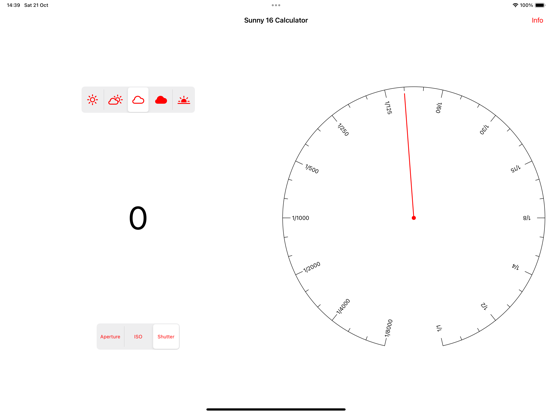Exposure Equivalence
iOS Universel / Photo et vidéo
The Sunny 16 rule is a handy rule of thumb in outdoor daylight photography; the rule estimates the required daylight Exposure Value without using a light meter.
This rule evolves around three concepts:
1) Incident light (as opposed to reflected light); an advantage for ‘difficult’ subjects.
2) The different lighting conditions in outdoor photography (sunny, slight overcast, overcast, heavy overcast, and open shade/sunset).
3) The relatively fixed exposure value for daylight under these conditions.
What the rule does NOT prescribe are the actual camera settings (aperture, ISO and shutter speed) that you can use, as long as the combination of manual camera settings lead to an equivalent exposure value as specified by the rule.
And this is exactly where the Exposure Calculator app comes in: it lets you
a) change settings for aperture, ISO and shutter speed, and
b) use ND-filters for which the filter density (the filter exposure compensation value) can be taken into account,
c) balance out all these settings to achieve a correct exposure in accordance with the entered lighting condition (either a Sunny 16 preset or a measured EV100 ).
The calculator supports the balancing process by indicating the resulting overall exposure value in stops RELATIVE to the selected lighting condition, taking into account a selected filter density.
The calculator can also be used as a ‘training device’, where you first guess the required combination of settings for balance, and subsequently check these with the calculator.
Explanation for the calculator screen, from top to bottom:
A) In the ‘lighting condition panel’, select a lighting condition. In the new version of this app, you can select a lighting condition from either the “Sunny 16” presets-scale, or from a more extended scale of Exposure Values (assumed to be measured at ISO 100). On the right side of this panel, you can switch between the two scales (“Sunny 16” or “EV100”).
B) The number display indicates whether the selected settings are in balance (indicated by 0), or whether a correction in the settings is necessary (indicated by a negative number for under exposure, of a positive number for over exposure)
C) If you want to change settings for aperture, ISO, shutter speed or filter density, you can select this in the switch just below the number display. Of course changing settings will lead to the number display increasing or decreasing; this exposure offset needs to be balanced out by using (a combination of) the other settings, until the displayed number becomes 0 again. The switch itself continuously displays the selected values for aperture, ISO, shutter speed and filter density.
D) The circular controls for aperture, ISO, shutter speed or filter density are displayed below (when the screen is in ‘portrait mode’) or to the right (in ‘landscape mode’). You can change the settings for the circular control either by tapping on the control or by moving the pointer.
Further characteristics:
- No in-app purchases
- No account, no login
- No advertisements
Quoi de neuf dans la dernière version ?
In addition to the already available “Sunny 16” lighting condition presets, this new version offers the possibility to enter measurements of incident ambient light (when using a handheld light meter). This provides for a larger and more detailed Exposure Value scale than the original five “Sunny 16” lighting conditions. The Exposure Value is to be measured with the light meter set to ISO 100; please note that the ISO value subsequently can be changed in the app.






